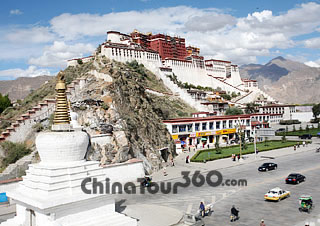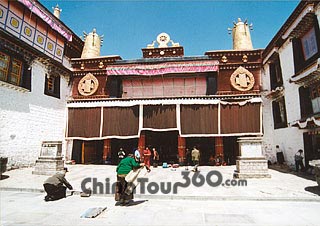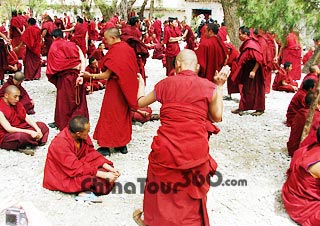Nicknamed Sunlight City, the capital city of Tibet Autonomous Region - Lhasa is the highest city in the world. With an elevation of 3,658 m, (12,000 feet), it is located on the north bank of Lhasa River, in a mountain-fringed valley. It is an old city with a history of 1,300 years. Covering an area of 30,000 square kilometers (11,583 square miles), the city governs seven counties and one district. People from 31 minorities have settled down in Lhasa like Tibetan, Han, Hui etc, of which 87% are Tibetans.
![]() City History
City History
Lhasa was originally a deserted swamp where human sparsely populated. The forests in the mountains around the city became the haunt of the beasts. Two stone hills were distinctly seen towering lonely on the plain.
Early in the 7th century AD, the ambitious chief of Tufan tribe Songtsan Gambo toured here and he discovered the two stone hills were similar in the shape of the dragon and tiger, what's more, the fertile soil was suitable for plant, and thus he had his ruling center transferred from Shannan to Wotang. In the year of 641 AD, he married Princess Wencheng of the Tang Dynasty (618 - 907). To offer decent housing for this respectable princess, he began to have a palace built in the summit of the red hill. The construction of the first Buddhist Monastery in Tibet-Jokhang Monastery started according to the proposal made by Princess Wencheng. When finished, it was named as Shanyang Huanhua Temple in commemoration of the goats that carried the materials for the construction. The city was renamed as Resa meaning Yangtucheng. Later, it gained its current name Lhasa. Ever since the 10th century, the religious center has shifted and alternated for several times, but Lhasa has remained the most important religious shrine in Tibet. In the 17th century, the fifth Dalai unified the snow-capped plateau again, which has made the city the administrative center of Tibet ever since.

Lhasa Maps
![]() Tourist Resources
Tourist Resources
Lhasa is one of the most characteristic and charming cities in the world owing to its beautiful scenery, age-old history, abundant cultural relics and strong religious atmosphere. Here, you can enjoy the World Cultural Heritage - Potala Palace, Jokhang Monastery, Norbulingka, famous Drepung Monastery, Barkhor Street to your heart's content. More and more tourists from every corner of the world have been attracted to explore this vibrant city and its mysterious culture as well. Also, the hospitality of local Tibetans makes you feel at home.
![]() What to see: Potala Palace, Jokhang Temple and Barkor Street, Namtso Lake
What to see: Potala Palace, Jokhang Temple and Barkor Street, Namtso Lake
Photos: Potala Palace, Jokhang Temple, Sera Monastery, Norbulingka
Drepung Temple, Ganden Temple, Tibet Museum
![]() Transportation
Transportation
At present, the transportation to the city has been greatly improved, and by air is no longer the only way in approaching this mythical land. Since October 1 of 2006, railway service to Lhasa Tibet has been launched from Shanghai, Beijing, Guangzhou, Chongqing/Chengdu, Xining/Lanzhou. The train hence sets on its long trip from East China to Xining, capital of Qinghai Province and on its further way from Xining to Lhasa over the so-called newly-built Sky Rail. The Qinghai-Tibet railway construction had been built in two stages. One section from Xining to Golmud, an important town in the west of Qinghai Province, was put into operation in 1984. The second section from Golmud to Lhasa, the capital of Tibet in length of 695 miles, has stations at Nacitai, Wudaoliang, Tuotuo River, Anduo, Naqu, Dangxiong, Yangbajing to Tibet.
![]() Recommended Lhasa Tour Itineraries:
Recommended Lhasa Tour Itineraries:
Lhasa Extension Tour: 7 Days Tour of Lhasa - Gyangtse - Shigatse - Lhasa
Lhasa Highlight Tour: 4 Days to Potala Palace, Sera Monastery, Norbulingka Park, Drepung Monastery, Jokhang Temple, Barkhor Street, etc.
Tibet Highlights Tour: 13 Days of Lhasa - Gyangtse - Shigatse - Dingri - the Everest Base Camp - Zhangmu - Katmandu











